Zinnias are the easiest flowers to grow at home from seed; they grow quickly and bloom profusely. Zinnia flowers are one of the easiest annual flowers to grow from seed. They have been used for decades as cut flowers in floral arrangements and bouquets.
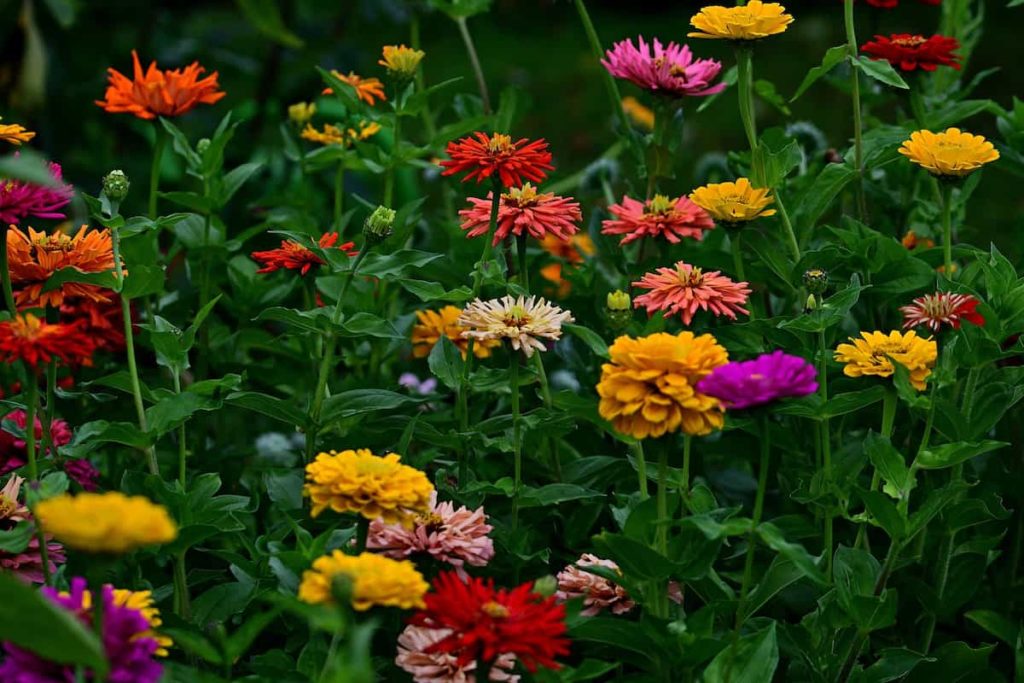
Flowers bloom in various forms, including dahlia-type, single, semi-double and double flowers. Plus, they’re great flowers for new gardeners to grow, as the seeds are easy to handle, and the flowers attract many species of butterflies. They require lots of sun, warmth, and well-drained soil and can be enjoyed from summer until the first heavy frost of fall.
How to grow Zinnias from seeds
Varieties of Zinnias
There are three main Zinnia flower varieties: single, semi-double, or double. The difference between these forms comes from the number of petal rows and whether or not the center of the flower is visible:
- Single-flowered Zinnias have one petal row and a visible center.
- Double-flowered Zinnia variety has numerous rows of petals, and their centers are not visible.
- Semi-double flowered Zinnias are somewhere between, with multiple rows of petals but a visible center.
Some main varieties to check out include:
- ‘Envy’: Bright, chartreuse green blooms
- ‘Carousel’: colorful and sturdy
- Burpee ‘Rose Giant Cactus’: has a vintage feel and full, pointed petals
- ‘Will Rogers’: Stunning red, large blooms
Companion planting with Zinnias
If there’s anything better than a hearty border of cheerful double Zinnias, it’s a garden of Zinnias with a partner to show them off to their best advantage. So grow the seeds of these winning companion planting combinations: Benary’s Giant Lime and Purpletop Vervain, Big Tetra Mix and Purple Night, Cut and Come Again and Red Fountain Grass, Persian Carpet and Blue Horizon, Perfusion Orange and Victoria, Star White and Black-Eyed Susan, and Zowie, Gold Flame and Purple Majesty.
In case you missed it: Vegetable Growing Season Chart in India: Sowing Guide, Germination and Planting Calendar
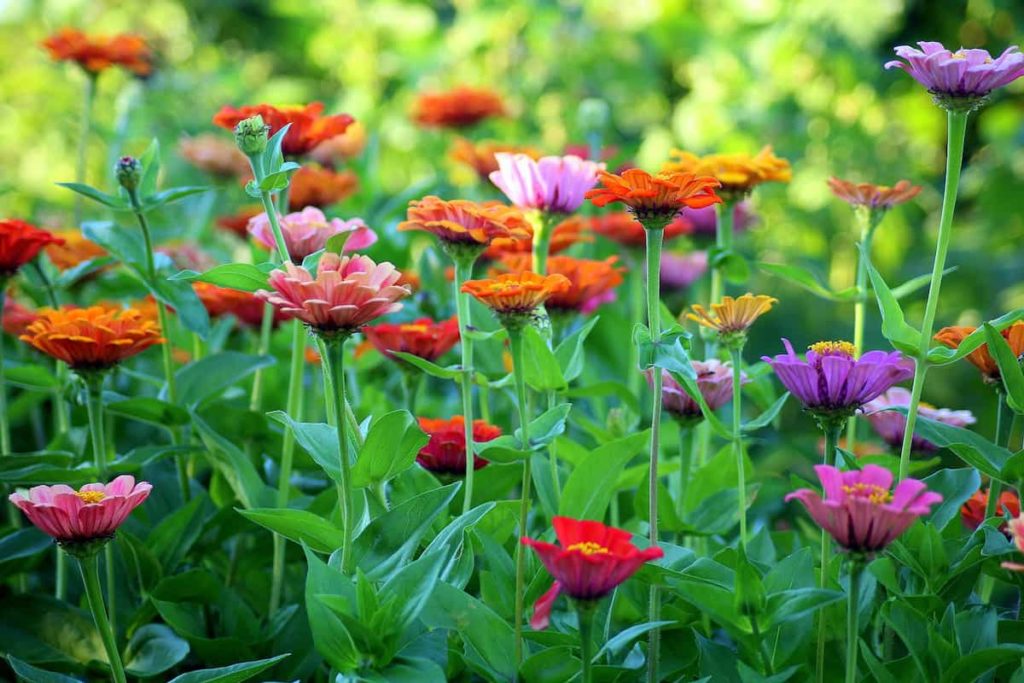
Soil requirement for growing Zinnias from seed
Once established, Zinnias are naturally drought tolerant but need moist soil rich in nutrients to grow and establish themselves. A mixture of loam, silty, peaty, and sandy soil provides adequate nutrition and moisture while draining well enough to prevent waterlogging of the new plant. Make sure your plant is in rich, loamy soil, and space the plants 6 to 18 inches apart, depending on the species. It will provide the Zinnia with enough soil surface area for optimal nutrition.
Zinnias must be seeded directly into the soil in warm climates after frost. In cooler weather, seeds can be started indoors in germination trays. Whether seeded directly into a bed or germination tray, Zinnia seeds should be sown in deep, well-drained soil to a depth of about a quarter of an inch. Seeds or plants in beds should be spaced about six inches apart for good airflow, and rows should be spaced 12 inches apart.
Zinnia seed germination and growth habits
Zinnias are known to germinate within about 7 to 10 days after sowing. It is best to refer to your seed packet for additional information on specific growing habits, such as height and spacing. Once the Zinnia plants are established, they will attract an array of beneficial insects to the garden, blooming all summer long.
Zinnia flowers make excellent cut flowers for many floral arrangements and bouquets. Once your Zinnias begin to bloom, you can begin to remove the old, spent flowers to encourage plant growth. However, since Zinnias are annuals, they will not regrow the following season unless their seeds fall below the bare ground. Therefore, when collecting the seeds, you should let the flower heads dry for the next growing season.
Easy way to plant Zinnia seeds indoors
Starting seeds indoors will require just a few supplies for a basic setup.
- Seed starting mix
- Zinnia seeds
- Heat mat
- Grow or store light
- Water
Step 1. Prepare your seed-starting supplies
- Fill your containers with seed starting mix. You can use seed trays, small paper cups, peat pots, or even old yogurt containers. Ensure the container has some drainage holes so that excess water can drain.
- A seed starting mix should include compost, perlite, and vermiculite, which is light, loose, and holds moisture well. Any garden center will have pre-made seed bags or make your own for less.
- Make sure the mixture is pre-moistened, or mix in some water. The soil should be moist but not saturated. A handful of the mix must form a ball that comes together lightly.
- Fill your seed tray, cup, or whatever container you’re using. Then, gently press the soil into the container.
In case you missed it: How to Grow Cucumber Plants Faster: Best Tips to Increase Flowering, Fruiting, and Production Yield
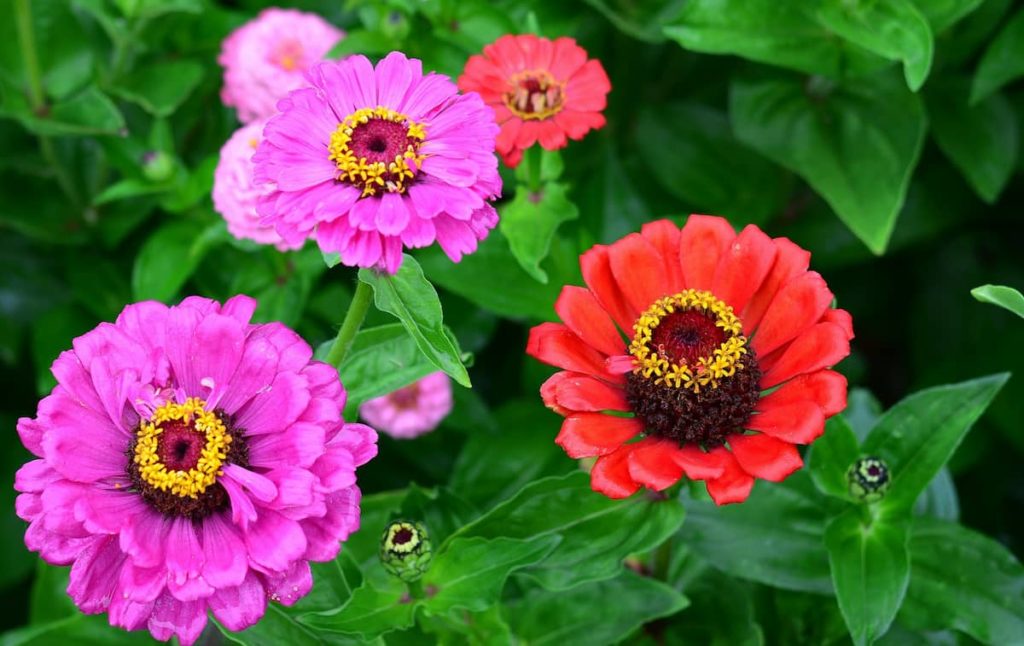
Step 2. Sow Zinnia seeds
- Take your Zinnia seed packet, and place one seed per tray on the soil.
- If you are using a container that has not been divided, place one seed every 2 inches on the soil’s surface.
- Zinnia seeds only need to be covered with 1/4 inch of soil. Mist the soil with a gentle stream to settle the seeds.
- You will need to water the Zinnia seeds regularly until they germinate. If the seeds start to germinate but then dry out, the seedling will die, and you will need to replant them, so remember to keep them moist.
Step 3. Place the seed tray under the light
- Place the seed tray under a row of shop lights, keeping the lights two inches above the soil.
- Zinnias are warm-season flowers and grow very quickly in warm soil. However, the Zinnia seeds may not germinate if the soil is too cold.
- Zinnia seeds germinate in a week if the soil temperature is 21-23°C. Lower temperatures will take longer, so if the seeds are in a cooler area, keep that in mind as you wait for them to germinate.
- Once the seeds have germinated, they will need 16 hours of direct light daily.
- During this time, keep the soil moist until the seeds germinate. Then, adjust the lights, increasing them as the plants grow taller. The light should be about two inches above the plants to keep them strong and give them room to grow.
Growing Zinnias in Pots
Zinnias grow well in pots or containers as long as you provide the correct type of environment to meet their needs. Make sure containers have good drainage and fertile soil. Please keep them in full sun and water regularly, and container-grown Zinnias will thrive. Zinnias thrive in full sun by locating the pot in a spot with about six hours of direct sunlight.
Well-draining and good soil rich in organic matter are ideal, but Zinnias will grow in almost any soil. Keep the soil constantly moist but not overwater, or the soil will become soggy. Proper pot drainage is also essential when growing Zinnias in pots. Planter pots bought from garden stores usually already have drainage holes. But they are unlikely in decorative vessels. So, if you’re using a decorative pot or container, you may want to drill some holes in the bottom.
How to save a dying Zinnia plant?
Save dying plants by giving them more sun, a liquid seaweed solution, and light fertilizer. Protect them from cold weather and frost by moving them near a masonry wall or housing them in a greenhouse. Give very dry potted plants a deep soak to help rehydrate the soil and repot them if the soil level has dropped.
Zinnia plants are summer-blooming annuals, so that they will die back in cooler weather in the fall. In addition, if your Zinnia is planted in the ground or is already growing in good-quality soil, it can benefit from a fertilizer boost. Dying Zinnia plants can benefit from a liquid all-purpose nitrogen-based fertilizer. Liquid fertilizers are short-lived so add some cheap fertilizer after 2 weeks.
In case you missed it: How to Grow Isabgol Plants for Beginners: Guide and Steps to Propagation, Planting, and Care
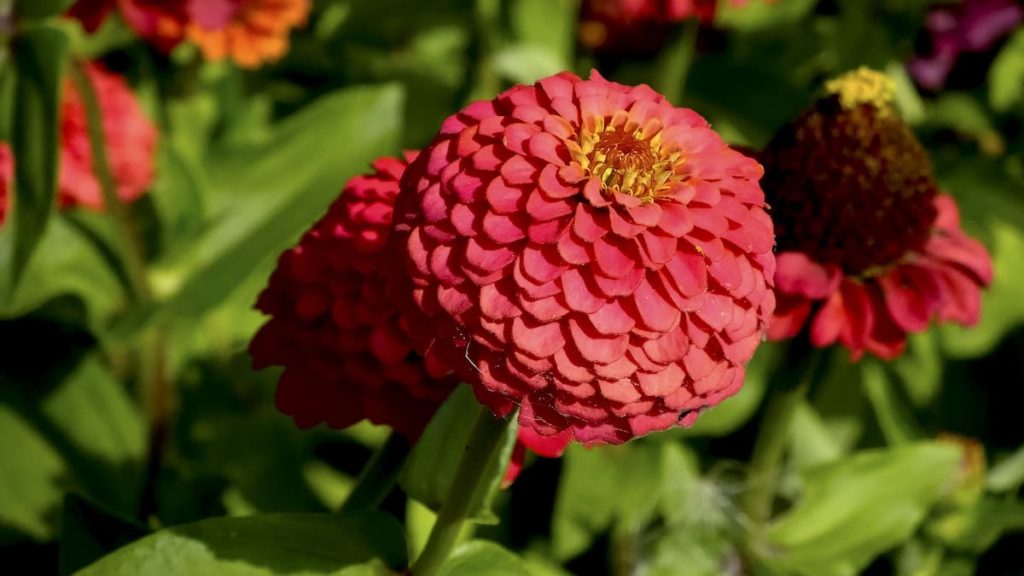
Seasonal care in Zinnia plants
Dividing and Transplanting
Zinnias are annual flowers, so division is not required. However, they can be difficult about being transplanted. If growing them indoors for transplants, use large peat or plastic pots, so you don’t have to transplant more than once. Also, try not to disturb the roots when moving the plants.
Trimming and pruning
Deadhead (trim) regularly to encourage more flowers and keep the plant tidy. To make bushier plants on tall varieties, pinch the growing tip of the plant when young. It will encourage more side branching, a smaller plant, and flowers. However, it can delay flowering, especially in cool summer areas.
Mulching
While Zinnias can grow well in average soil, they’ll do better with compost or mulch. Once the Zinnias are established, mulching with a two-inch layer of straw or bark will help retain soil moisture and prevent weed growth. Also, the light at the planting stage. Fertilizer can be applied. Side dressing with an organic 5-5-5 fertilizer at flowering will produce more numerous and larger blooms. Seeds can also be sown directly into one to two inches of organic mulch throughout the season. It will provide nutrients as the mulch breaks down and becomes compost.
Pests, diseases, and their control in Zinnia plants
The major pests of Zinnias are powdery mildew and the Japanese beetle. Powdery mildew disease is prevalent in humid regions of the country during late summer. A white film forms on the leaves. Eventually, the leaves turn yellow and fall. The entire plant can be affected quickly, making it look untidy and reducing overall flowering. Space plants further apart to prevent powdery mildew, increase airflow, grow disease-resistant varieties, and then apply preventative sprays early in the season.
Neem oil and Serenade (Bacillus subtilis) are two organic sprays that work well to prevent the spread of powdery mildew. You can make your organic spray by mixing 1 tablespoon of horticultural oil with 1 tablespoon baking soda in 1 gallon of water. Aphids can also attack Zinnia leaves, causing them to curl and turn yellow. Remove aphids from Zinnia leaves with a strong spray of water from a hose.
You can find common garden pests such as aphids, caterpillars, mealybugs, and spider mites on your Zinnia flowers. In addition, Zinnia diseases can include powdery mildew, wilt, and bacterial and fungal spots. Avoid diseases by being careful not to splash water on the leaves when watering. Japanese beetles love caterpillars and can often be found feeding and shredding leaves.
To control Japanese beetles, apply beneficial nematodes or milky spore powder in early summer and fall into the ground to kill the C-shaped, white grubs. These are adult beetle larvae. Use beneficial nematodes in cold areas. To reduce adult beetle populations in the summer, place Japanese beetle traps around your property at least 200 feet from your garden. That way, flying beetles will find the trap before they find your plants. You can also pick the adults up in the morning when they are sluggish and drop them into a pail of soapy water.
In case you missed it: How to Grow Green Chilli Peppers Faster: Best Tips to Increase Flowering, Fruiting, and Production Yield
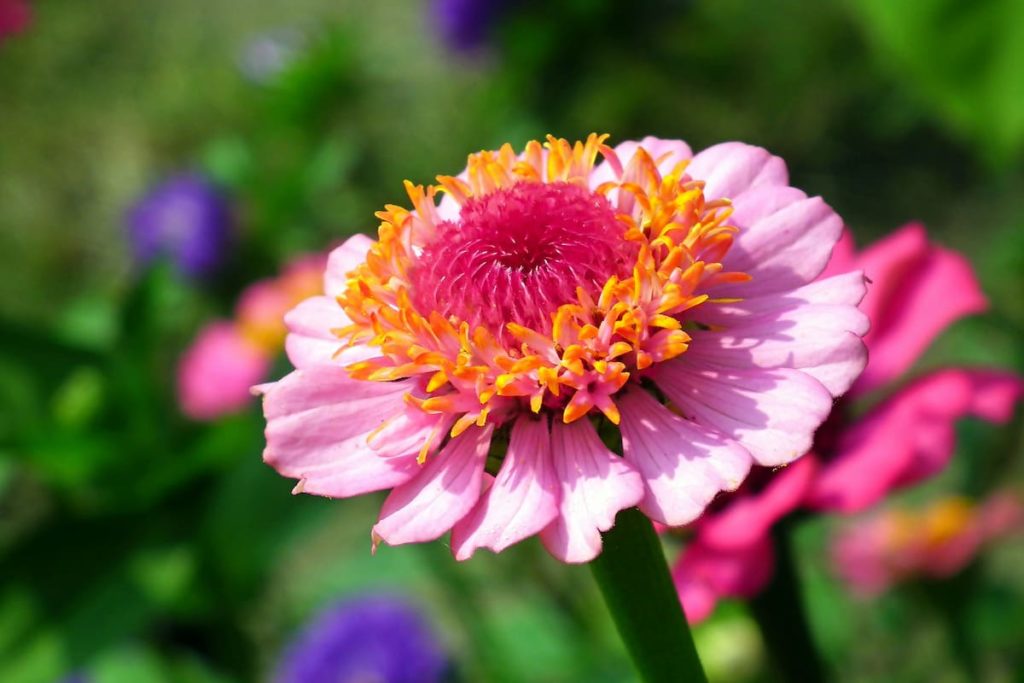
Troubleshooting in growing Zinnia plants
Yes, growing Zinnias is easy. But sometimes, you run into trouble and have no idea what’s wrong or how to fix it. So, solve some common Zinnia care problems, and give you tips on how to fix them.
Yellow leaves – This is most likely due to a lack of nutrients, but it can also be caused by overwatering. If you suspect a nutrient deficiency in the plants, start feeding the plants with an organic liquid fertilizer. Otherwise, the soil is never wet or wet.
Leaves turn brown – can be from underwater or sunburn on new plants. Never let the soil dry out completely. If your new starts or plants have brown leaves, move them to a shady spot and gradually introduce them to the full sun over the next few weeks.
Black leaves – If the leaves have black spots, they are likely infected with bacterial leaf spots, which can be prevented by keeping the leaves dry. Otherwise, if the leaves suddenly turn black, it is probably caused by frost or freezing temperatures.
White powder on leaves – When you see white color spots that look like powder on leaves, it is likely powdery mildew. Once infected with the plant, you cannot get rid of it. But you can’t treat the leaves with an organic fungicide and water at the base to reduce spread.
Zinnias won’t bloom – There are some reasons why Zinnias won’t bloom, or they don’t have many buds. It is caused by either too much shade, improper watering, or lack of nutrients. Please ensure they are in a sunny spot, that the soil dries out between waterings but is never bone dry, and that you feed them regularly.
Harvest flowers frequently to encourage more blooms
Zinnia flowers do not bloom once they are cut. Cut the flowers when the petals have opened, and the stem has hardened. If you are not harvesting flowers for cut flowers, deadhead the spent flowers to encourage the plant to produce new flowers (not seeds).
Save Zinnia seeds for all seasons
At the end of the season, stop blooming at the largest, prettiest flowers. Allow the flower head to dry completely on the plant. When the flower head dries and breaks, the seeds are ready. Petals will dry up and fall off. The seeds are the big, plump center of the flower head. Harvest seeds to plant in your garden next season.
In case you missed it: How to Grow Moringa Tree Faster: Best Tips to Increase Flowering, Fruiting, and Production Yield
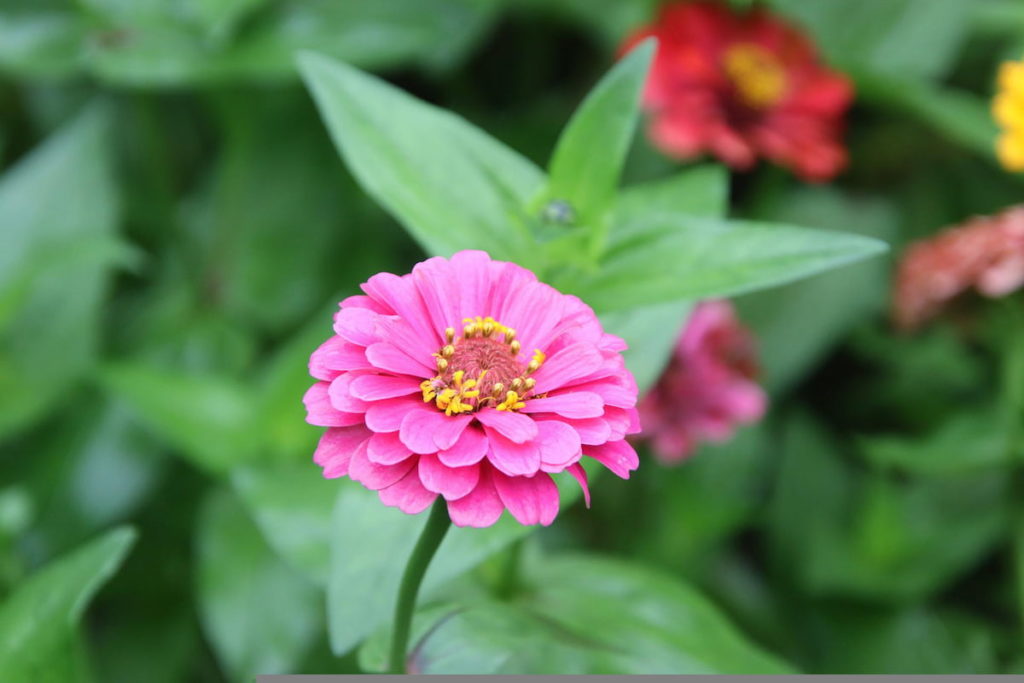
Frequently asked questions about growing Zinnias (FAQ)
Is Zinnia easy to grow from seed?
Zinnias are easy to grow from direct seed in the garden. For early flowering, start seeds indoors 4 to 6 weeks before your last frost date.
Do I need to soak Zinnia seeds before planting?
Zinnia seeds do not need to be soaked before planting.
Do Zinnia seeds need cold stratification?
Zinnias do not require cold hardening or chilling the seeds before planting. Since Zinnias are warm-season annuals living in warm regions, the seeds are adapted to germinate without exposure to cold.
At what temperature do Zinnias grow?
The ideal temperature for growing Zinnia seeds is 21-23°C. A heat mat under the seed tray will bring the soil to this temperature range.
Do Zinnias like sun or shade?
Zinnias thrive in full sun and should be planted early in the warm season.
Can Zinnias grow in pots?
Zinnias are a colorful addition to any flower garden – they’re great for cutting, easy to grow, and start from seed – so they’re a great choice for container gardening.
Can you grow Zinnias indoors?
Zinnias are a popular annual in the flower garden. You can grow Zinnias indoors if you grow them under fluorescent grow lights or in a greenhouse.
Why is my Zinnia wilting?
Zinnias need plenty of water for their best growth, so leaf drops and wilting are one of the first signs they suffer from drought stress. Zinnias need at least an inch of water per week, sometimes more if the weather is hot and dry.
Conclusion
Zinnias are beautiful flowers for beginning gardeners. These annual flowers are available in different colors, and varieties can add great color to your garden and are perfect for creating bouquets. In addition, Zinnias are low maintenance and will thrive. Zinnias have been a firm favorite among gardeners for decades; they bring an absolute explosion of color, are easy to grow, and are loved by essential pollinators like bees and butterflies.
- Management Pests and Diseases in Your Cotton Field
- Sheep Farming Business Plan for Beginners
- Aquaponic Farming at Home: A Step-By-Step Guide
- Profitable Village Farming Business Ideas in 2024
- High-Yield Aquaculture: Fast-Growing Fish for Farming
- Effective Fish Pond Construction Techniques for Beginners
- Irrigation and Water Management in Pineapple Farming
- Blossom to Harvest: Mastering Flowering and Pollination in Papaya Farming
- Pig Fattening Essentials: From Selection to Sale for Beginners
- Raising Wagyu Cattle: A Complete Guide for Premium Beef Production
- Soil Types and Their Water Holding Capacity
- Optimizing Irrigation Schedules for Coconut Groves for Enhanced Yield
- Espresso Your Garden: Coffee Grounds for Healthier Acid-Loving Plants
- The Best Soil Mix for Snake Plants: How to Mix Your Own Snake Plant Soil
- Green Thumb Success: Expert Tips for Cultivating Greenhouse Beans All Year Round
- Bloom All Year Round: The Ultimate Guide to Indoor Hyacinth Care
- Eco-Friendly Gardening: How to Make Liquid Fertilizer from Kitchen Waste
- Ultimate Guide to Grow Anise in Pots: Explore Seed Propagation to Harvesting
- Guide to Raising Chester White Pigs: Discover Breed Facts to Growth Management
- Mastering the Elegance: The Ultimate Guide to Weeping Cherry Tree Care, Planting, and Maintenance
- Ultimate Guide to Planting Garlic in Grow Bags: Growing Strategies for Beginners
- How to Fix Spider Plant Leaf-Related Problems: Natural and Organic Remedies
- 10 Reasons Why Your Tulsi Plant is Shedding Leaves: Home Remedies and Solutions
- Optimizing Growth and Yield: The Advantages of Palm Bunch Ash Fertilizer
- Utilizing Neem Oil Extract as a Natural Pesticide for Hydrangea
- From Soil to Harvest: Various Ways in Which Farmers Can Use AI Tools
- Steps to Encourage and Induce Citrus Flowers: A Comprehensive Guide
- How to Fix Snake Plant Leaf-Related Issues: Natural and Organic Remedies
- Transform Your Garden into a Fragrant Oasis with Raat Ki Rani (Night Blooming Jasmine)
- Discover the Ideal Chicken Breeds for Philippine Farms
- How to Create a Poultry Egg Farm Business Plan for Profits
- Grow Lemon Cucumbers Like a Pro: Insider Techniques for Bountiful Yields
- Ultimate Guide to Caring for Your Pink Princess Philodendron: Tips for Thriving Variegation
- Areca Nut Profit Per Acre: Calculating Yield and Cost of Cultivation
- How Kaveri Chicken is Becoming a More Profitable Breed in Indian Backyards
- Transform Your Barn: 9 Steps to Convert a Horse Stall into a Chicken Coop
